This Saturday, October 16th, the launch window for Lucy, a NASA mission designed to explore for the first time Trojan asteroids associated with the orbit of Jupiter. They orbit the Sun in two loose groups or clusters: one ahead of Jupiter in its path and the other behind it. These primitive bodies contain essential clues to decipher the history of the solar system.
These primitive bodies contain vital clues to decipher the history of the solar system.
“It is likely that the Trojan asteroids are remnants of the same primordial material that formed the outer planets (Jupiter, Saturn, Uranus and Neptune), so they serve as ‘time capsules’ for the birth of our Solar System, more than 4,000 million years ago”, he explains to SINC Tom statler, Lucy Program Scientist at NASA Headquarters.
According to the researcher, the main theory about how Trojan asteroids got to where they are involves a dynamic instability which caused sudden large changes in the orbits of the giant planets.
“In this scenario, small objects from across the outer solar system were widely scattered, most were ejected to the farthest reaches of the solar system or beyond, and a few lucky survivors made their way to Trojan orbits or other stable niches like the belt of Kuiper ,” adds Statler.
If this image is correct, Lucy will find objects that originally formed in different parts of the Sun’s outer disk, where the first solid bodies condensed. “Lucy will give us insight into the physical and dynamic processes that affected these planetary building blocks and will help us unravel the early history of the solar system at a time when planet formation was ending and planets were moving towards configuration. orbital we see today”, he emphasizes.
Lucy will find objects that originally formed in different parts of the Sun’s outer disk, where the first solid bodies condensed.
Tom Statler (NASA)
Twelve years of space travel
With its launch and the momentum of Earth’s gravity, the spacecraft will complete a voyage of 12 years per eight asteroids different: a Main Belt asteroid and seven Trojans, four of which are members of binary systems.
According to the United States Space Agency, no other mission in the history of space has been launched to explore so many different destinations that orbit independently around our Sun. Lucy will thus show for the first time the diversity of primordial bodies that built the planets.
One of these asteroids will be Polymele, which is expected to reach in 2027, and of which Spanish and American astronomers obtained data in early October as they passed in front of a star.
Named after the Australopithecus afarensis
Just as this fossil allowed us to learn more about human origins, it is hoped that the probe will allow us to gain “more knowledge about our planetary origins”, says NASA Science Program Director, Adriana ocampo.
According to Ocampo in a conference at the Caixa Forum in Madrid on September 23, it was NASA’s first mission “built during a pandemic under extraordinary conditions”. The team developed “new work and cooperation techniques to meet the times needed for the launch to take place on Saturday, October 16th”.

During the course of her mission, Lucy will pass seven Trojans from Jupiter. This animation shows the movements of the inner planets (Mercury, brown, Venus, white, Earth, blue, Mars, red), Jupiter (orange) and the two swarms of Troy (green). / CAS Astronomical Institute / Petr Scheirich
Source: PAN
Rights: Creative Commons.
.
